Osteochondrosis is the most common cause of back pain.The damage to the intervertebral disc underlying the development of the disease was found in every second person who has been around 40 years, and at age 50, 70% of the population is amazing.At the same time, today osteochondrosis is found in young and teenagers.Intervertebral hernia, radicolite, brain supply disorders - all of these are complications of osteochondrosis that threaten defects and often cause defects.
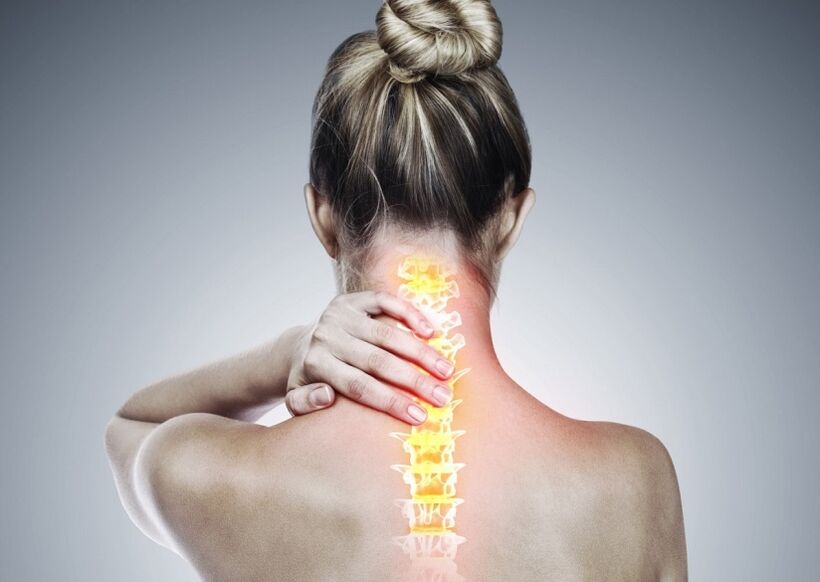
Currently, effective methods of treatment allow not only to eliminate symptoms, but help to restore the destroyed area of the vertebra, in traditional medicine almost none.Therefore, it is very important to understand the factors that lead to disc destruction, what needs to be changed in their lifestyle to stop the development of osteochondrosis.And what steps to take to overcome existing changes and to improve the recovery process in the spine.
What is osteochondrosis?How does the disease develop?
Osteochondrosis is a disease in which the process of destruction in the spinal segment begins -begins for the recovery process, which is characterized by back pain, mobility limitations, and so on.
The intervertebral disc (hereinafter referred to as "disc") is an elastic cloth ring, fiber woven into a deep and underlying vertebra.Due to its special structure, the intervertebral disc protects each vertebra from destruction, and also ensures the mobility of the entire spine (tilments, rotates).
In the middle -the intervertebral disc is a pulp core, which resembles a liquid -filled rubber pillow.In adults, it consists of 70% of water, as well as carbohydrates that can bind and give water.At the time of load on segments that match the spine, the core provides water and flatters, and after termination of the effect of taking the previous form.The shocking pillow allows the spine for the spring and extinguishes up to 80% of the shock load that comes to the spine.
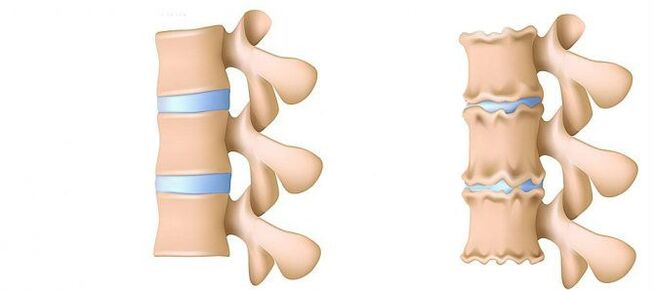
The degenerative-dystrophic process most often begins with a deterioration in the intervertebral disc shock absorption function.
- Deterioration of blood supply to the intervertebral disc.In adults, intervertebral disc foods are performed by spread: blood is only conveyed to vertebrae, and has passed through them it "absorbs" to the disc.In the best way, the disc is powered during dynamic load (for example, walking), due to the principle of pump (fluid outflow processed when compressed, nutrient and oxygen flow when removing loads).Therefore, the diet of intervertebral disc is difficult especially in the state of inactive lifestyle (hypodynamia).
- Nucleus change of pulpic disc.With the deterioration of blood supply, water supply, sugar and amino acids to the pulpoose nucleus is disrupted.Therefore, the production of carbohydrates connects the suffering water.Nucleus dehydration, its structure made of gel -such as turning fibrous, the ability to extinguish and extinguish the shots.This increases the load on the fibrous ring and vertebrae, they are more likely to be blocked and injured.
- Changes in an intervertebral disc fibrous ring.Due to leveling the pulpoose nucleus, the increase in load lies in the fibrous disc ring.In poor blood supply, the fibrous ring loses its strength.Spinal instability occurs, which can cause the formation of intervertebral hernia, vertebral displacement and damage to the spinal cord or nerve root.
- Disk prominence.The formation of intervertebral hernia.When the fibrous ring fibers weaken, the pulpic nucleus begins to stick, for example, towards the intervertebral canal (disk protrusion).As surprising can lead to the rupture of fibrous rings and hernia formation.Read more about the process of intervertebral hernia formation in a separate article - "Effective treatment of intervertebral hernia at home".
- Spondylosis - the destruction of intervertebral joints (spondylartrosis), growth of osteophytes and ligaments.In line with the formation of intervertebral hernia in osteochondrosis, damage to the intervertebral joints, changes in vertebral (cartilage) and ligaments are observed.
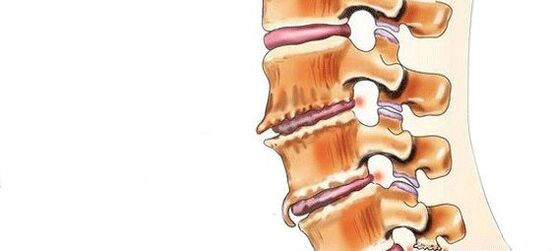
Because the shock function that absorbs the intervertebral disc is not performed, the vertebral and small intervertebral joints begin to be injured.
Spinal instability is also the cause of damage to the body's cartilage -vertebral body and articular processes.As a result, bone tissue grows, osteophytes appear(From Greek: Osteo - Bone, Phyto - Plant)- Bone growth.The appearance of osteophytes is generally called spikes or salt deposition.
- Osteophytes can constantly irritate the ligaments of the vertebra segment, which gradually lead to their ossification and limit the movement of the affected spine.
- Osteophytes can also injure nearby soft tissue, the result is the accumulation of dead cells in it, in which the body reacts to inflammation (edema).
- Osteophytes on the surface of the vertebrae facing the intervertebral disc damages the fibrous ring fibers, accelerating the formation of the hernia.Osteophyte, which grows towards the intervertebral canal, increases the spinal cord, blood vessels, nerve roots.
- Growth of osteophytes can lead to neighboring vertebrae wrap and loss of complete mobility in the vertebral segment.
Symptoms and signs -to
Symptoms and signs - Osteochondrosis - back pain!Initially, back pain can occur due to overstrain back muscles trying to centralize excess vertebra (stage 3), so the muscles protect the spinal cord located in the vertebral column.The spinal cord is the middle part of the nervous system, so the body tries to prevent its damage (squeezing, irritation).Furthermore, the cause of the pain may already be a vertebral vertebra, a hernial highlight of a small size.During the appearance of hernia, a person, as a rule, experienced severe pain (this is called cervical or lumbar lader).
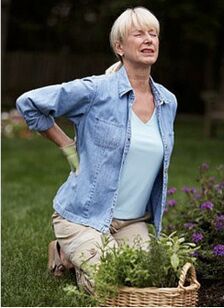
Because of the pain in the back, one voluntarily strives to take a position where the intensity of the pain decreases - forced, forced.At the same time, the spine is in a strong position that reduces the disk depreciation ability.This increases the risk of further damage.
As a violation of the joints, the development of the vertebral body, the articular and ligaments, the patient's spine begins to lose mobility.Partial, and then complete the restriction on the movement of the affected spine.
Complications of spinal osteochondrosis
There are several stages of development of spinal osteochondrosis complications.Their manifestation depends on the department where the damaging process occurs.
- Radiculite discogenic (radiculopathy), where hernial protrusion reduces the nerve roots (a group of nerve fibers, prolonging the spinal cord and then divided into nerves that go to one or other area of the body).The pain is caused by the mechanical effects of the hernia on the spine, and the addition of inflammation (edema).
- Vascular-brown syndrome, where vessels are squeezed that feed the spinal cord.It is characterized by affected movement in the hand (with cervical osteochondrosis) or lower leg (with lumbosacral), as well as loss of sensitivity.With these complications, the functioning of the internal organs can suffer, in which the affected nerves go (urine, sexual function, intestinal function, etc. -more) can develop, hypertension can develop and memory deterioration occurs.Sometimes vascular infarction occurs suddenly, with sharp movements in the affected area -more often, at the bottom.There is a sharp pain and a sudden muscle weakIshias paralytic“.
- A violation of blood supply to the spinal cordDue to compression of the vessel that feeds the spinal cord.Extreme levels of complications are ischemic spinal stroke.The result of these complications is impaired movement in the limbs (paresis, paralysis), loss of sensitivity, deterioration in the functioning of the internal organs to resolve the rejection.In some cases, this can lead to death of the patient, for example, when the function of the kidney is serious.
Symptoms of Discogenic radiculitis depend on the spine:
| Location | Symptoms and signs -to |
|---|---|
| Radiculite cervical, cervix-thoracic | Depending on the degree of damage, pain and sensitivity to the neck, shoulders, arms, fingers occur.Muscle weakness in these departments can also be observed. Often participating in occipital neuralgia, where severe pain in the back of the head is observed.Arrhythmia may occur. |
| Lumbar-size radiculite | It is characterized by pain in the lower back, often combined with pain during the sciatic nerve - Ishias, Ishiradiculite.Foot muscle weakness also develops, violations of sensitivity in the thighs, lower legs, and feet may occur. |
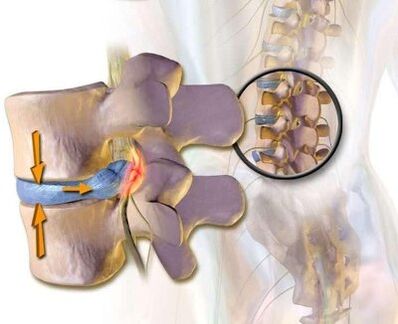
Transfer of the vertebral body or intervertebral disc with the inauguration of blood vessels and subsequent nerve roots may require immediate surgical intervention.
Causes -Development of spinal osteochondrosis
Osteochondrosis is called multifactorial disease - that is, there are many reasons for its occurrence.Here we will produce two main factors that gradually lead to the loss of intervertebral disc and subsequent changes in the spine:
- Deterioration in the state of the power supply of the intervertebral disc, as well as cleaning their tissues.
- Excessive load on the spine, leading to the accumulation of dead cells in the vertebral segment tissue.
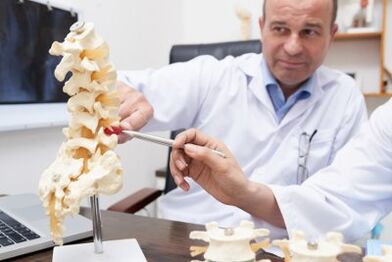
Intervertebral disc tissue updates depend on the adequacy of blood flow and lymph flow directly to the intervertebral disc, no blood or lymph (which works in the body to cleanse tissues).Disc food and cleaning are done indirectly, that is, slowly.This is why in this area not only happened quicklyLack of nutrients and hunger of oxygenbut also quicklyDamaged and dead cells gatheras well as materials.Cleaning of fabric from "slags" is necessary, otherwise there will be no place for new functional cells, and then the fabric will gradually lose its function (for example, the pulpoose core of the disc will stop in the spring, depreciation and will be flat).
Updating intervertebral disc tissue depends on the adequacy of blood flow and lymph flow.The speed and strength of this process are influenced by the microvibration of the created (especially) back muscles during physical stress.In this case, one of the reasons for food deficiency and cleansing is hypodynamia when the back muscles are relaxed or in a static position.
When osteochondrosis develops, blood supply, lymph and venous flow in the spine can decline becausemuscle cramps.The body signals the muscles to keep the vertebra in a certain position relative to each other in the affected area.For a long time, the overstrown muscles squeeze the ship for a long time, which continues to worsen the situation.
It is clear to most people that the spine can suffer in the case of unusual sharp lifts or when injury, however, damage the spine can be daily and not significant if it violates the neuromuscular depreciation system.Persistent microtraumas in poor lymph flow lead to the accumulation of dead cells, inhibit the growth of functional cells, and thus lead to tissue modification.
A violation of neuromuscular depreciation as one of the main causes of osteochondrosis
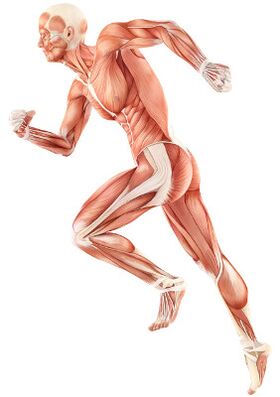
Depreciation of neuromuscular depreciation as one of the main causes of osteochondrosis to reduce the burden on the spine while walking, lifting weight, and more.The body has the entire system of neuromuscular depreciation.It is ensured by the functioning of the body's nervous system and the skeletal muscle that interacts in agreement to ensure smooth movement and eradicate the surprise load on the bones, joints and, of course, the spine.Therefore, most shock loads should erase the feet.Also, the leg and back muscles are involved in depreciation.If this does not happen (for example, high uncomfortable shoes do not allow the legs to function), the intervertebral disc is subject to a surprise they are not intended.Factors that lead to disagreements in neuromuscular depreciation systems are listed below:
- A violation of posture- various types of spinal curvature that prevent it from "appear", the use of nonfiological furniture while working in the office, etc.
- A gait violation, running the technique (right when walking, moving weight from foot to heel);
- Wearing high shoes or without heels, which negatively affects the ability of foot depreciation.
- Excessive load(playing sports, exhausting physical labor), traumatic joints and spine
- Obesity- Excessive weight shifts the center of gravity of the body, as well as adipose tissue complicates blood supply to the muscles, nerve impulses;
- Driving in the transportation sitting without depreciation (in a standing position, you can appear with your feet);
- Disorders of the functioning of the nervous system, for example, because the use of painkillers that negatively affect the conductivity of the nerves.
- Kidney disorderDue to excessive formation in the body of the product damage.This may be associated with inadequate physical activity - a prerequisite for the work of the lymph system, which is responsible for cleaning tissue from metabolic products and dead cells, as well asliver disease, chronic focus of inflammationetc.
Hypodynamia
One of the causes of widespread osteochondrosis in recent decades is an inactive lifestyle outbreak.The back muscles and newspapers in normal life are not involved enough and quickly weaken, and strong muscles are required for spinal health that is not burdened with static tension, but is busy with dynamic work.The back muscles are the fastest weakening with hypodynamia, which is full of the following consequences:
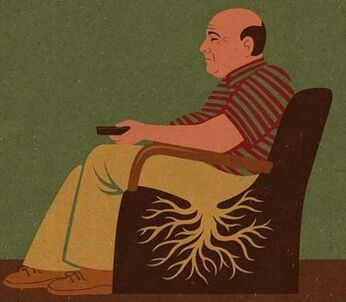
- Insufficient support from the spine in a careless movement, leading to the load of the intervertebral disc, the vertebral displacement and the occurrence of the intervertebral hernia.
- The deterioration of blood supply to the spine: Dynamic function of the skeletal muscle is a prerequisite for blood flow to any organ, including the spine.As a result of inadequate muscle surgery, changes in the progress of the intervertebral disc - dead cells due to lack of nutrients and oxygen.And dead cells gather, interfere with recovery.
- The deterioration of lymph flow and venous outflow, leading to the accumulation of dead cells in the tissue.The skeletal muscle work is very important for the work of the lymph system, as most vessels (for example, lymphokapillary) do not have a muscle wall, and "push" the lymph in the bloodstream depending on the work of the skeletal muscle.
4 Principles of Effective Treatment
In order not only to eliminate symptoms, but to overcome the cause of the development of osteochondrosis, spondylosis, radiculitis and ishias, the following tasks need to be completed:
- Make the opportunity to clean tissue from dead cells.This is a requirement for recovery to prevent further formation of osteophytes and to free the space for tissue regeneration.To do this, restore/strengthen the lymph flow and venous outflow from the affected segment;
- Increase blood supply to the affected area;
- Increase the tone of all muscles that support the spine.This will allow:
- Create conditions for stimulationownblood flow and lymph flow in the spine;
- Recover the operation of the neuromuscular depreciation system, which is required for sufficient support for the spine, to prevent new damage.
- Eliminate pain, as this will give you the opportunity:
- Remove muscle clamps that block blood flow to the spine;
- Avoid forced pose.
Medication therapy (medicine)
Today, in the treatment of osteochondrosis and its complications, the following group drugs are used:
- Necepoid Anti -Inflammation of Drugs (NSAIDs)- In the form of tablets or drug injections.These funds have the ability to reduce pain, reduce inflammation.However, the effect of its use does not last long - from a few hours to two to three days.Therefore, such funds must be taken for a long time - weeks, and sometimes months.At the same time, these drugs negatively affect the mucous membranes of the gastrointestinal tract.Their length acceptance is full of gastritis, ulcerative lesions.In addition, they can affect kidney, liver, and contribute to the development of hypertension.And, at the same time, this fund does not contribute to the cleaning of the disc from dead cells.Therefore, its use is just one way to relieve the symptoms for a while, but does not eliminate the main problem.
- Ctepoid (gopmonal) anti -inflammatory drugs.As a rule, it is used for severe and irregular pain that accompanies hernia, radiculitis, ishias, and others.Gopmons has the ability to eliminate manifestations of inflammation (due to suppression of the immune system), relieving pain.But they also negatively affect the mucous membranes of the stomach and intestines, promoting the release of calcium from the bone, inhibiting their own gopmon production.And does not contribute to cleaning the focus of dead cells.
- Papasmolics- Medicines that affect the muscles or nerves that go to the muscles, and cause skeletal muscle relaxation.This means helping to relieve muscle clamps for a while, reducing pain and increasing blood flow.But at the same time, they do not help clean the tissue from dead cells.Therefore, they do not contribute to cure osteochondrosis.
- Epiduvision blockade- Introduction of painkillers and goponal agents into the space between solid brain skin and periosteum covering vertebrae.It is used, as a rule, for intense pain - during the acute period of intervertebral hernia, with severe radiculitis, ishias.Depending on the composition, such injections help relieve pain for several hours to several days.After the expiration date, the manifestation of the disease is restored, as the procedure does not help restore the metabolic process in the disc.In addition, when it is performed, there is a risk of injury to the blood vessels and nerves.
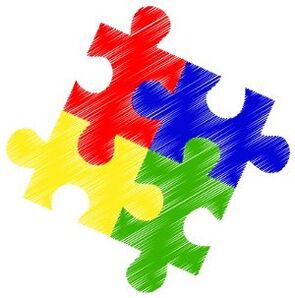
As osteochondrosis and the development of complications progressYou need to use the medicine more often, increasing the dose.This leads to high financial costs, as well as health deterioration due to side effects of drugs.
Drug therapy, as a rule, is supplemented by the immobilization of one or spinal cord using different orthopedic corsets -different levels of stiffness.
























